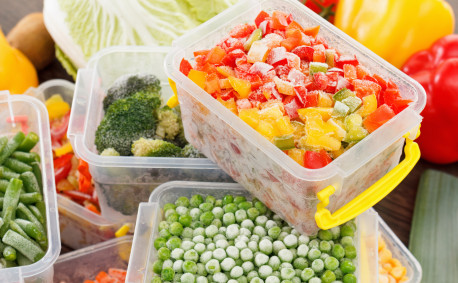How to Save Money at the Grocery
We could all use a break from high prices these days. If you want to save money on groceries without sacrificing flavor or nutrition, we have five tips to help you stick to your budget.
1. Planning Is Key
When you shop without a list, you’re likely to spend more. Plan your meals ahead of time and know what you need so you don’t get distracted by other items. You can also plan around specials. Check out your grocery store’s website to look for discounts on key ingredients and plan your meals around those to save more.
Have you ever bought an item only to realize you already had some at home? Shop your pantry first. Not only can you avoid buying duplicates, but you can also be inspired to build a meal around ingredients you already have. After a while your supplies will dwindle, but you might be surprised how much food you have stored away.
Limit your shopping to once a week instead of every few days. The more trips you take, the more time and gas you waste, and the more you expose yourself to temptation.
Select your shopping location deliberately. Certain items may be less expensive at another store. Make sure the cost of gas and time is worth the savings. You can also build your meal plan accordingly and shop different stores in different weeks to maximize your savings.
2. Shop Less Expensive Options
When meal planning, consider building your recipes around lower cost items. For example, proteins such as beans and eggs tend to be less expensive than meats. Rice, potatoes and oats are all good options for low-cost carbohydrates. Canned or frozen fruits and vegetables may cost less than fresh produce. Similarly, whole fresh fruits and vegetables cost less than prepared versions such as pre-cut produce. Foods such as oils, seeds, nuts and sardines are good sources of fats, but they can be expensive. The good news is you tend to need less of these ingredients.
When shopping for meats, keep in mind that tougher cuts tend to be less expensive. Slow cooking is a great way to prepare tough meat, and it can yield freezable leftovers. Also look for meat cuts that are higher in fat content such as ground beef or chicken thighs, as they cost less than their leaner counterparts.
While cooking from scratch tends to cost less in the long run, you may need to weigh the benefit of cost over convenience depending on your schedule. It’s ok to lean on prepared foods if that’s a better fit for your lifestyle. Plus, some prepared meals are portioned to help reduce food waste.
3. Make Ingredients Do Double-Duty
Leftovers are a great way to save time, plus they can save you money by reducing food waste. Any food you end up not eating is money you’re throwing away. The average family of four wastes $1,500 worth of edible food per year.
Another way to save money and reduce food waste is to preserve your extra ingredients. Sometimes we need only a small amount of an ingredient, but the packages contain much more than that. Freezing and pickling are great options. For example, you can freeze extra fresh herbs in oil, freeze lemon or lime juice, or pickle leftover onions.
4. Look for Deals
Look for coupons or sign up for your favorite store’s loyalty program for built-in savings. You can also follow brands on social media, as they may offer special discounts to followers. Shopping apps can also help you save.
Proceed with caution. Stores and brands can entice you to spend more money through these programs. They may offer coupons on non-essential items, promote items that cost more or require minimum purchases to qualify. Don’t impulse-buy simply because you’re shopping through an app or reward program, and make sure the discounts are worth it.
Generic staples such as canned vegetables, cheese and certain oils cost less, but be selective. If you have health considerations that require you to follow a low-sodium diet, for example, be sure to compare product labels, as nutritional contents can vary. Some brands are reviewed as tasting better, splurging on a pricier option may be worth it.
Scan up and down the shelves. Stores put alluring products at eye level. Just watch kids in carts on cereal aisle to see this principle in action. Many eye-catching items are nice-to-have or brand-name products that will end up costing you more.
5. Logistic Hacks
When you can, pay with cash. We tend to spend more money when we charge items to a credit card. But when you have a fixed amount of cash, it prevents you from overspending.
Instead of focusing on the total cost of an item, pay attention to the cost per unit. Sometimes an item that’s less expensive overall might be smaller and cost more per unit.
If you’ll get a lot of use from an ingredient, consider buying a bigger package or buying in bulk. This larger up-front cost can save you money over time, but only if you need the items. So, make sure the extra expense in the moment is the best choice for your budget.
Shop on Wednesdays, if possible. Stores tend to release new discounts on Wednesdays, which means you’ll get first crack at sale items. This is also the day when stores are least crowded. Fewer shoppers means less stress, which can lead to clearer thinking and better budget-conscious choices.
Some of these tactics may not seem like big money savers, but every bit makes a difference, and the savings will add up over time.
More Helpful Tips








